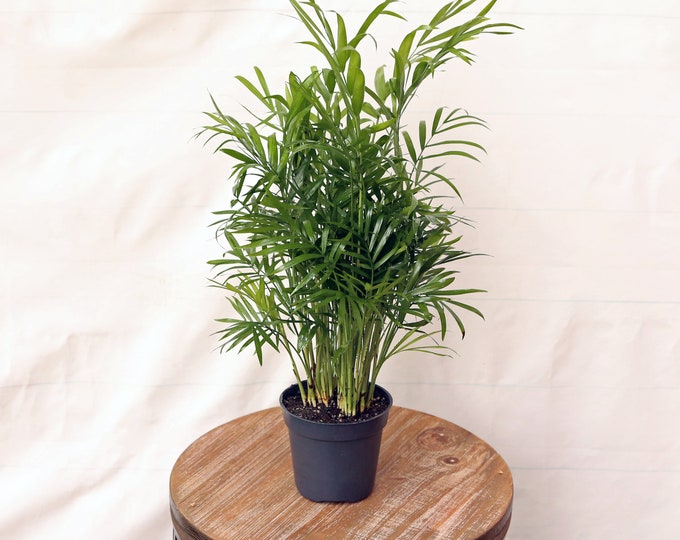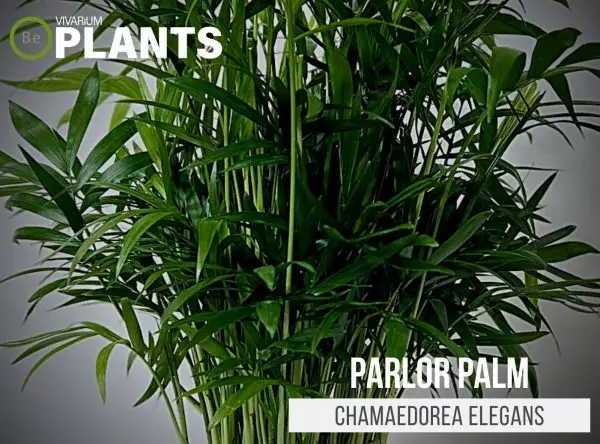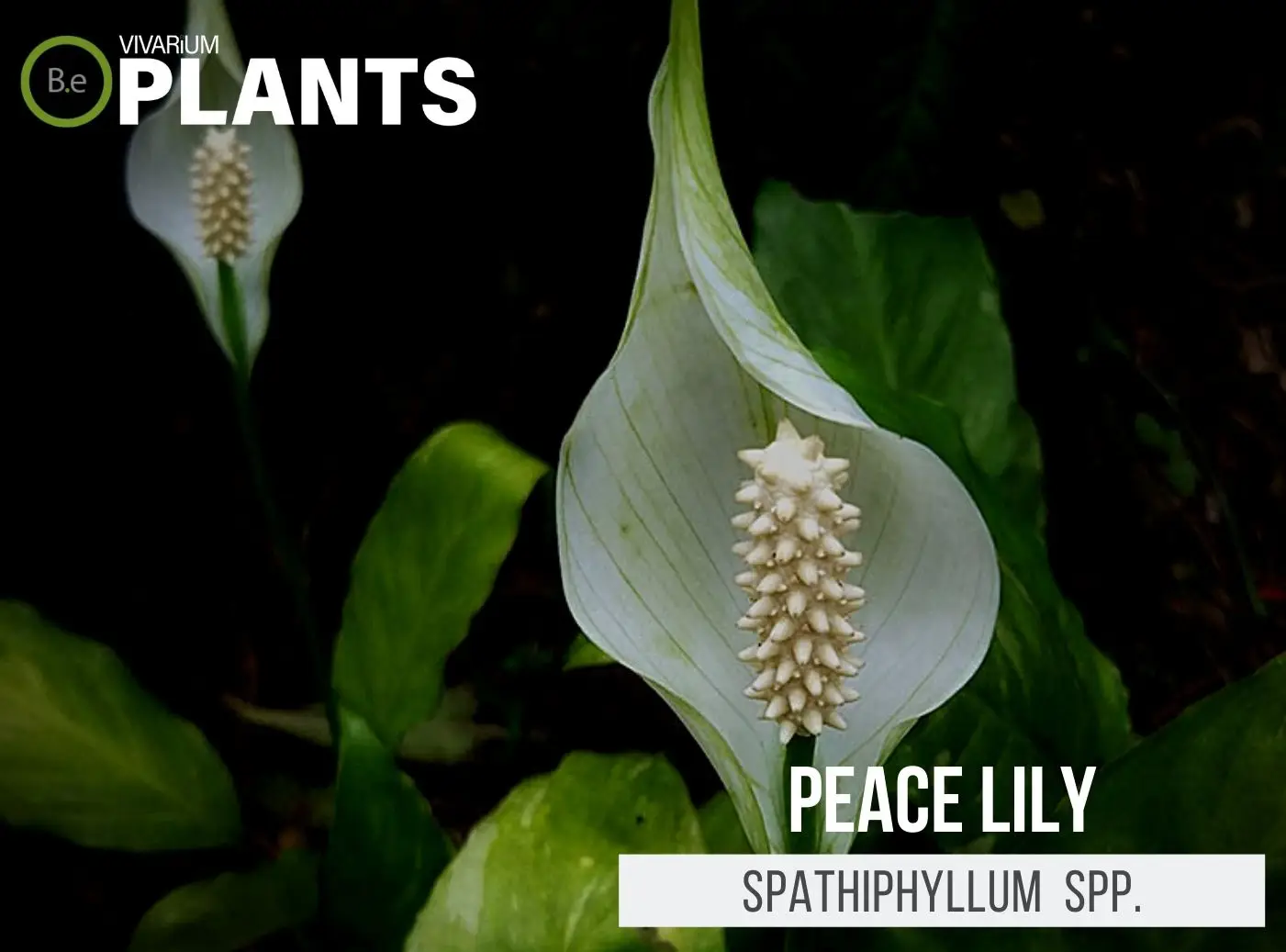Chamaedorea elegans (Parlor Palm) is a hardy terrarium plant that is popular for both its beauty and its low maintenance care requirements.
It is a slow-growing, evergreen palm, with bold, deeply-lobed, dark green fronds that are perfect for adding a beautiful tropical look to any vivarium.
This is a great starter palm, as anyone from the beginner to the advanced gardener can easily cultivate it and maintain it with minimal effort.
| Quick Stats: | |
|---|---|
| Scientific Name | Chamaedorea elegans |
| Common Name | Dwarf Palm, Neanthe Bella, Parlor Palm |
| Family Name | Arecaceae |
| Habitat | Tropical Rainforests |
| Temperature | 60°F to 80°F |
| Height | 6 to 10 feet |
| pH | 6.1 to 6.5 |
| Lighting | Medium to bright indirect light |
What is a Parlor Palm?
Chamaedorea elegans is an evergreen palm that grows small and tight clumpings and has a slow growth rate.
Its narrow stalks can reach heights of up to 10 feet tall.
The slender, lacy-looking fronds will reach a length of around two feet and spread up to three feet wide.
Its fronds are generally a dark green color with yellow-green leaflets that are deeply and narrowly divided.


Parlor Palm Facts
This is a great plant for those who would like to have an elegant, low-maintenance indoor plant.
Unlike other palm trees, parlor palm does not require an excessive amount of light or water and tolerates average indoor temperatures quite well.
It is also considered pet-friendly and is not toxic to cats and dogs.
Description
The parlor palm is a beautiful, evergreen dwarf palm tree with narrow-stemmed stalks reaching up to 10 feet in height.
Its fronds are usually composed of yellow-green leaflets that are deeply and narrowly divided.
They can reach up to two feet in length and three feet in width. It also has bright green berries that are two to three millimeters in length.
Habitat
Dwarf palm is native to tropical rainforests and is widely cultivated in many parts of the world for its beauty and its low maintenance requirements.
This palm can be grown both indoors and outdoors in a variety of environments from full sun to shade.
pH Preference
The ideal pH range for parlor palms is 6.1 to 6.5. Too high or too low of a pH can be detrimental to the health of the plant.
Vivarium Type
The parlor palm is quite an easy-going species. With that in mind, it will not be too complicated when it comes to choosing the type of enclosure it is grown in.
It is best to try and replicate the plant’s natural habitat as much as possible.
Doing so will make it easier to provide this foliage plant with its basic needs.
The proper setup and theme of the enclosure will make a big difference to the overall look and health of the plant.
Be sure to choose setups that are moist and high in humidity. Here are recommended vivariums it will do well in:
- Paludariums – Half aquatic/ half terrain-based enclosure.
- Terrariums – Fully terrain-based enclosures with little to no aquatic features.
Vivarium Placement
This is a great plant to add to any terrarium as it is both attractive and low maintenance.
Even with its dwarfed height, I would recommend using this plant as a midground or background plant.
It enjoys indirect light and is best kept in a slightly moist environment with humidity levels between 40-60%…
Keep that in mind when placing this tropical plant in a tank.
Substrate
Parlor palm prefers a well-draining substrate such as a terrarium soil mix, vermicompost, or sand that is mixed with peat moss.
The substrate should be kept slightly moist but not soggy as this can cause root rot.
Lighting
This palm tree does best in medium to bright indirect light. This means that direct light from a window should be avoided as it can scorch the leaflets.
We have a really good terrarium lighting guide that this plant would be well suited for.
Buy Parlor Palm
When it comes to buying parlor palms, there are a few things to keep in mind.
Making sure the plant is healthy when purchased is essential for its success in a vivarium.
Vegetation that is already in poor conditions will have a very hard time adjusting to new environments.
Click the image below to find out more about the current price and other relative info about this plant.


Parlor Palm Care and Propagation
This dwarf palm is an easy plant to care for and propagates easily from a single-stem cutting.
When propagating, the bottom of the cutting should be placed in suitable potting soil and lightly watered.
Once planted, the soil should be kept lightly damp but not soggy.
How to Grow
Parlor palm can be grown from a single stem cutting and prefers bright indirect light, moderate humidity levels (40-50%), and well-draining soil.
It should be watered when the top inch of soil is dry and fertilized every 3-4 months.
Watering
Watering should be done when the soil is dry to the touch. Avoid overwatering as this can lead to root rot.
Plants Similar to Parlor Palm
Adding diversity to an enclosure is key to an aesthetically pleasing setup.
Try mixing up the look of your vivarium with different flora that can easily co-exist in the same types of environment.
Furthermore, if for some reason you find parlor palm hard to acquire or would like to consider something similar to this plant…
Here are other foliage plants you might find will do well with or in the place of this dwarf palm:
Conclusion
Parlor Palm is an attractive, low-maintenance, tropical terrarium plant that can provide a bright, jungle look to any room.
It has beautiful, lacy fronds with yellow-green leaflets, and is an excellent plant for beginner gardeners.
It prefers bright indirect light, moderate humidity levels, and regular watering when the soil is dry to the touch.
Frequently Asked Questions
Yes, Parlor Palm (Chamaedorea elegans) make great indoor plants! They are low–maintenance and thrive in bright, indirect sunlight. They are also pet–friendly, drought tolerant, and remove harmful toxins from the air.
Caring for a parlor palm is easy! Here are a few tips:
• Make sure the plant is receiving plenty of indirect light, but avoid direct sun. • water thoroughly when the top inch or so of soil is dry.
•(BUNUS) Fertilize the plant with a balanced houseplant fertilizer every 3–4 weeks during the growing season.
• To help keep up humidity for your parlor palm, mist it regularly.
• Trim off any brown fronds with sharp, clean scissors. This will help keep the plant looking neat.
To water an indoor Parlor palm, it‘s best to let the topsoil dry out between waterings. Water the plant until the topsoil is moist and allow any excess water to drain out. How often this should be done depends on the temperature and humidity of your home – typically once per week is sufficient.
The parlor palm is a slow grower, typically adding only 1 to 2 feet in height over a period of several years. As an indoor plant, the parlor palm can survive without becoming too large, making it a good choice for smaller spaces.



